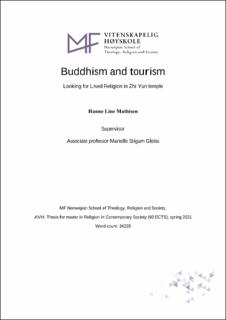Buddhism and tourism : looking for lived Religion in Zhi Yun temple
Master thesis
Permanent lenke
https://hdl.handle.net/11250/2825384Utgivelsesdato
2021Metadata
Vis full innførselSamlinger
Sammendrag
The main topic for this thesis is the mixture of Tourism and Buddhism in China, to ask the question of what takes place when a tourist visits a Buddhist temple. Can sightseeing also be a religious experience? Resulting in the research question: How does a group of Chinese tourists experience a Buddhist temple and in what ways can their experiences be interpreted as spiritual using the approach of Lived Religion? In order to understand the dynamics at play here, this master thesis includes the historic backdrop and current situation for religion in China, especially Buddhism, as well as rural tourism which includes a special focus on ethnic minorities whose religious heritage at times are used as a part of the tourist industry. The field work consists of eight interviews with tourists at a Buddhist temple, Zhi Yun. This temple is located close to a tourist hot spot, Lijiang old town, but has until now been out of the tourist spotlight, so mainly only catering to religious activities. The findings were analysed using the concept Lived Religion as a frame for understanding spirituality. Several of the interviewees partook in religious practice, and many described an experience more related to spirituality or religiosity then to sightseeing activity. Despite this, no participants identified as Buddhist. The serenity and scenery, together with the religious tropes and symbols can be said to be the emotional activators, by what Riis and Woodhead would call emotional regimes.
